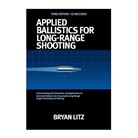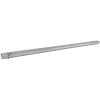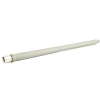In the ever-continuing search for a better-performing round, it is common to see ammunition being tested in ballistic gel. This brick of “Jell-o” like goo approximates the same consistency of mammalian flesh, though not the total composition, which includes skin and bone. Scientifically speaking, it provides a standardized medium in which to gauge penetration, expansion, temporary stretch cavities, and permanent wound cavities. Today, I’ll be covering how to make ballistic gel at home. Soon, I’ll follow up with calibrated gelatin to compare how close or far the homemade recipe gets us.
First, I want to cover the difference between homemade ballistic gelatin and calibrated ballistic gelatin. The standardized gelatin is tested (and adjusted) to meet a specific density requirement, so all batches should theoretically be close enough for standardized results. The stuff we make at home should be as close to the calibrated gelatin as we can make it.
Live Inventory Price Checker

|
Applied Ballistics For Long-Range Shooting - Applied Ballistics For Long Range Shooting 3rd Edition | Brownells.com | $ 69.99 |
|

|
Ballistic Advantage Premium AR-10 24" Rifle-Length Gas 6.5mm Creedmoor 1:8 Stainless Steel Barrel | GunMag Warehouse | $ 318.99 |
|

|
Ballistic Tip Ammo 243 Winchester 90gr Ballistic Tip - 243 Winchester 90gr Ballistic Tip 20/Box | Brownells.com | $ 45.99 |
|

|
Ballistic Advantage Premium AR-10 18" Mid-Length Gas 6.5mm Creedmoor 1:8 Stainless Steel Barrel | GunMag Warehouse | $ 280.25 |
|
The homemade ballistic gel gives us a fun visual test medium, aesthetically customizable targets (stock up on Halloween skulls), and the ability to modify the medium to satiate our curiosity. We can do this by adding a layer of deer hide, soft body armor or beef ribs to see how the bullet’s performance is affected. Any modification to the standardized tests renders the results incompatible with bullet tests using the standardized methods, but that doesn’t mean the information isn’t useful.
ClearBallistics.com details the FBI-standardized 10% gelatin they use:
“The FBI protocol we follow is firing a standard .177 caliber (4.5 mm) steel BB from an air gun over a chronograph at 590 feet per second (fps), plus or minus +/- 15 fps into the ballistic gelatin. The penetration of the steel BB must result in 8.5 centimeters (cm), plus or minus 1 cm, penetration (2.95 inches to 3.74 inches).”
The standard block is 6″x 6″16″.
Now that we’ve covered the difference between calibrated and “good enough for most of us” gelatin blocks, here’s how you do it.
Supplies.
- Gelatin
- Water
- Measuring cup
- Stockpot
- Non-stick cooking spray
- Target form, generally rectangular, works best—small trash can, planter box, Square 4-gallon bucket, etc.

I have bought both Knox gelatin powder and Great Value gelatin powder. Online bulk and in-store at Walmart, I’ve been able to find gelatin powder down to ~$.70/ounce. We need 1 ounce of powder for every 8 ounces of water. That’s 4 oz powder per quart of water and 16 oz powder per 1 gallon of water.
Step 1: Mix water and gelatin
Heat the water, there is no need for boiling. Hot, but cool enough to get your hands into. Slowly pour the powder into the water while whisking with a fork. Once all the powder is in, use your hands to try and break up any chunks. The light foam on top is no concern. Most bubbles will pop on their own, while the rest will be taken care of later.


Tip: A spoon with fine holes is great for scooping the final few chunks of undissolved powder, and either discarding them or squishing them between the holes to break them down easily.
Step 2: Cool the mixture
The whole mix will be solid after a few hours in the fridge.
Step 3: Re-melt
The pot you used to mix the gelatin should now be placed in a hot water bath. I use my kitchen sink for my stock pot, plug it, and fill the sink with hot tap water. In time, the gelatin will re-melt, and all air bubbles will be released.
Tip: Use a fork to cut up the gelatin into smaller chunks and they will liquefy faster.
Step 4: Prep the objective
Whatever your target form is, spray the inside with vegetable oil, silicone spray or whatever non-stick coating you like. I used Pam cooking spray. This reduces the chance your gelatin brick will tear when you remove it from the mold.
Step 5: Pour and chill
Pour your liquid mixture into your target mold. Put the target mold into the fridge. I used a small garbage can, which netted a 12″ deep target. Spoiler alert: not deep enough!

Step 6: Transport and shoot
You can take the ballistic gel brick to the range while still in the mold or pop it out at home and give it a cling-wrap jacket. Either way, transporting it in a pre-chilled, iceless cooler is best. Out in the sun, gelatin will (eventually) start to liquefy, so keep it chilled as long as possible. Contact with ice or similarly cold substances will affect gelatin density. While I set up my range equipment, I left a reusable shopping bag on the gelatin brick to keep the sun off it. Worked great.
The three rounds shot into the gel in the video were:



When I get calibrated gelatin in, I’ll test and compare the results, as well as upgrading my slow-motion video from 60fps to 240fps.
Set up your brick, and shoot away! It is best paired with a chronograph to get impact velocity and a camera with slow motion. The ballistic gel can be reused; just start back at step 3 and remove any foreign debris.
Have you made ballistic gelatin at home? Sound off in the comments and share your experience with other shooters who may be considering it.
About Rex Nanorum
Rex Nanorum is an Alaskan Expatriate living in Oregon with his wife and kids. Growing up on commercial fishing vessels, he found his next adventure with the 2nd Bn, 75th Ranger Regt. After 5 tours to Afghanistan and Iraq, he adventured about the west coast becoming a commercial fisheries and salvage SCUBA diver, rated helicopter pilot instructor (CFII) and personal trainer, before becoming a gear reviewer and writer.” –Rex Nanorum, @Rexnanorum






I have tested different types and brands of bullets on deer and elk for 50 years and it’s a one time only test each time . Most have been very successful in filling my freezer . Bullet recovery varies due to size of game and shot selection . I have a box full of recovered bullets and they all did the job well .
I’ve found that a good sized gooey wet mud hole at the bottom of a hill and a clear backdrop can give a good approximation of stopping power.
I’ve been using 20-24+/- oz gelatin to one gal water… hmmm… maybe I’ve been testing my loads for bodybuilders, LOL!
I’ll try 16gelo/gal-water & try the reheat for bubbles (why i went with 20+/oz per gal),,, sounds netter.
$0.45/oz at bulkfoods.com (I am not affiliated with them, just found the cheaper price). That’s for buying 5 lb. which may be more than some people want.
A most useful article,Thanks
Rex,
I would guess that the second melting and subsequent cooling are meant to achieve a more dense block. Please elaborate on the reason for the second melting.